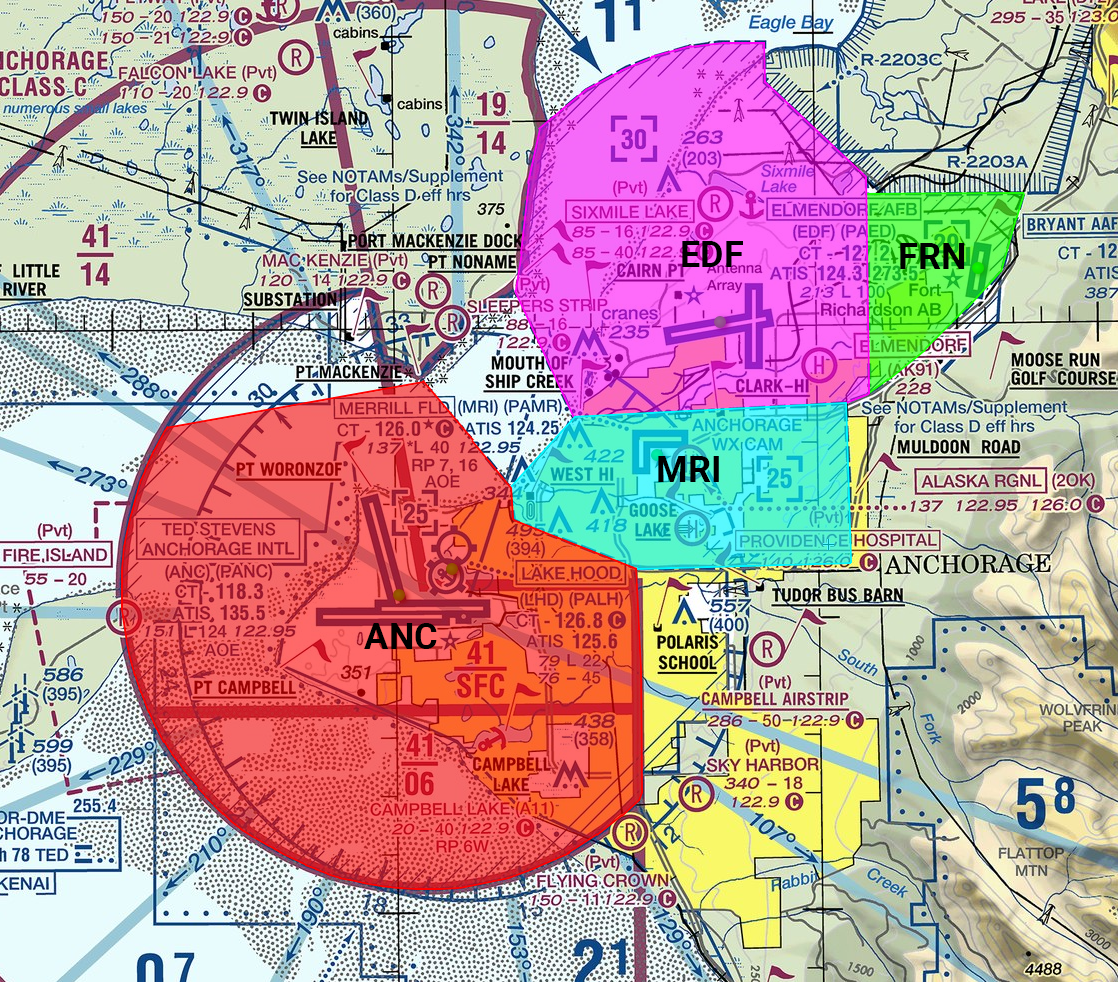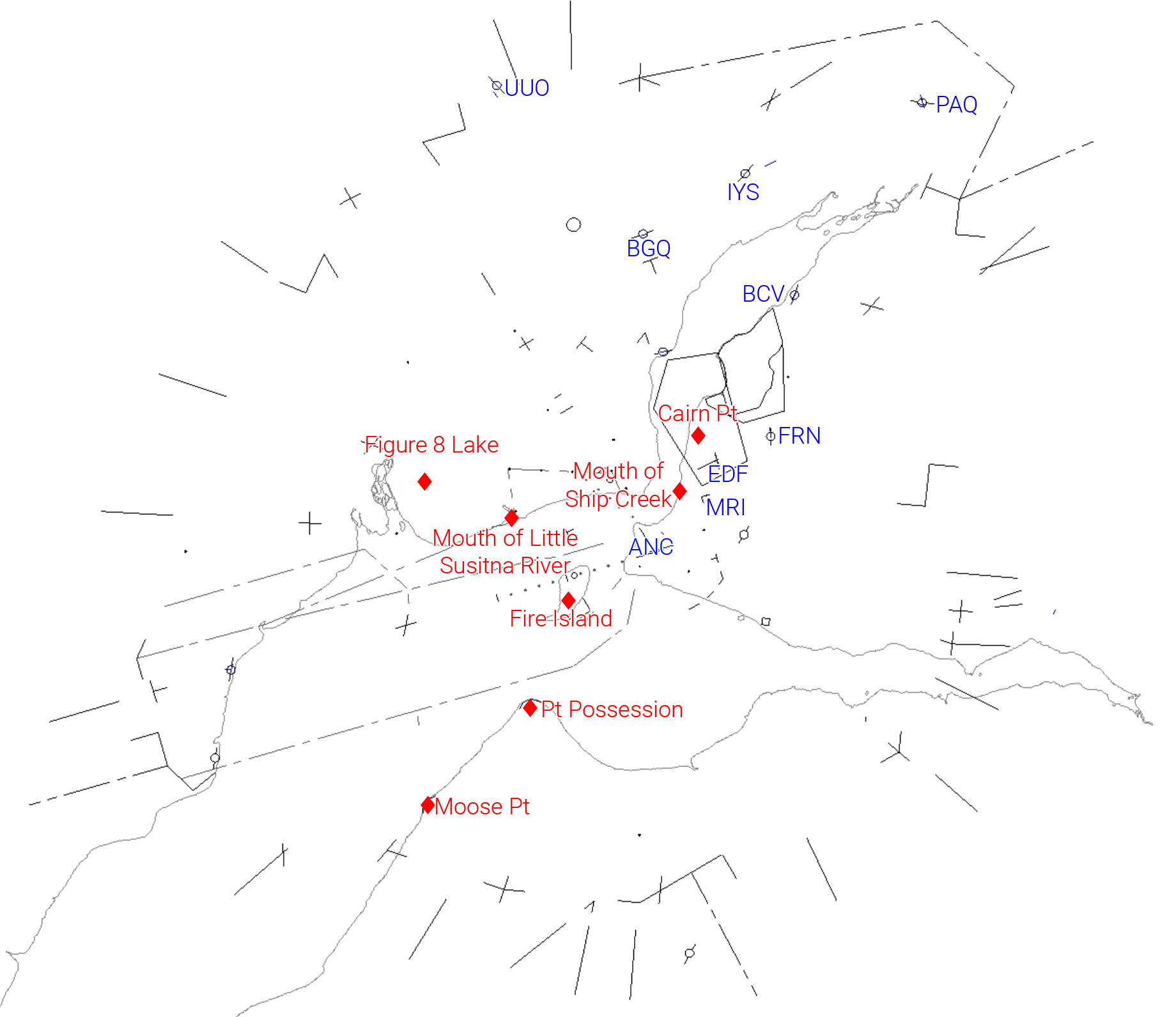Anchorage ATCT #
General Info #
Attendance: Continuous
METAR: Loading
TAF:
Loading
Positions #
| Position | Name | Abbreviation | Frequency |
|---|---|---|---|
| ANC_DEL | Anchorage Delivery | ANC CD | 119.4 |
| ANC_GND | Anchorage Ground | ANC GC | 121.9 |
| ANC_TWR | Anchorage Tower | ANC LC | 118.3 |
| LHD_TWR | Lake Hood Tower | LHD LC | 126.8 |
General Notes #
- ANC LC is responsible for all aircraft operating on the ANC Class C surface area, including LHD aircraft unless the LHD LC position is opened
Clearance Delivery #
- IFR Aircraft
- Initial altitude is 4,000 feet
- All aircraft should be assigned a SID appropriate for the active runways. Aircraft unable to accept a SID should be assigned a heading and altitude that mirrors that of the ANC # SID.
- Example (Runway 33 Departure): “Alaska 50, Cleared to the Barrow Airport as filed. On departure, fly runway heading. Passing through 600, turn left heading 301. Maintain 4000. Expect FL360 10 minutes after departure. Departure frequency 118.6. Squawk 1234.”
- Departure Frequencies, when both sectors are opened (with pronunciations):
- ANC# (Anchorage #) - 118.6 (North Radar)
- FFITZ# (Fits #) - 126.4 (South Radar)
- KNIK# (Ka-nick #) - 118.6 (North Radar)
- NOEND# (No End #) - 118.6 (North Radar)
- POTTER# (Potter #) - 126.4 (South Radar)
- TURNA# (Turn-again #) - 126.4 (South Radar)
- VFR Aircraft
- Should be instructed to remain VFR at or below 4,000 or otherwise directed by approach
- If both sectors are opened: aircraft traveling from 250 clockwise to 070 should be given a departure frequency of 118.6, otherwise 126.4. Otherwise, use the frequency of the open sector.
- LHD Aircraft
- If the aircraft is at LHD but requesting IFR, advise that IFR operations from LHD are not authorized
- VFR aircraft should contact LHD LC or ANC LC for departure instructions
Ground Control #
- When Runway 7/33 in use:
- Assign Runway 33 for departing:
- Wake Category A-E turbojets
- DC-6 and other aircraft unable to comply with climb gradient
- Northbound aircraft
- Assign Runway 7 for departing:
- All other aircraft
- All southbound aircraft
- Assign Runway 33 for departing:
- LHD aircraft should be advised to contact LHD LC or ANC LC for departure instructions
ANC Local Control #
- Retains control of ground traffic between the 7/25 parallels and west of Runway 15/33
- Ensure aircraft commence the first turn of the SID prior to switching to departure
- All aircraft are assumed released for departure unless otherwise coordinated with the radar controller
- Unless otherwise coordinated, missed approach instructions shall be the published missed approach. FR may issue the following:
- Runway 7L/7R/15: Leaving 600, turn right heading 200. Climb and maintain 2500.
- Runway 25L/25R: Fly heading 250, climb and maintain 2500.
- Runway 33: Leaving 600, turn left heading 300. Climb and maintain 2500.
Runway selection guidance #
Primary runways are based on traffic, forecasted wind, weather and neighboring traffic flows:
- Arrival runways:
- First preference: 7L/7R, or 15
- Second preference: 33
- Last preference: 25L/25R
- Departure runways:
- First preference: 33 and 7L
- Second preference: Day 7L/7R, Night 25L/25R
- Last preference: 15
- Day is defined as 0700-2200 local time. Night is defined as 2200-0700 local time.
- Selection of preference is based off of:
- Wind, including gusts, resulting in 15 knot crosswind or 5 knot tailwind or greater
- Wind shear, reported or forecasted
Primary Diverse Vector Area #
Primary Diverse Vector Area defines departure headings for IFR departures may be issued for operational efficiency as listed. These headings must be coordinated with, but not need approval from, the appropriate departure controller. LC should take care to ensure there is no conflicting traffic by utilizing the Tower Display Workstation (TDW).
- Runway 7L: Right turn 206 clockwise to 253, left turn 254 clockwise to 004.
- Runway 7R: Not authorized
- Runway 15: Not authorized
- Runway 25L/25R: 185 clockwise to 015
- Runway 33: 185 clockwise to 015
LHD Local Control #
- Operated from ANC LC and is combined with ANC LC when not staffed
- Identifies as “Lake Hood Tower” only when staffed
- Issues VFR departure instructions to keep aircraft clear of the ANC departing and arriving traffic
Appendices #
Appendix A. Airspace #
LC is delegated airspace as depicted from surface up to and including 2,500 feet MSL. This area is defined as 090 bearing from the ANC ATCT to New Seward Highway, then south along New Seward Highway to a 5.2 nautical mile radius, then clockwise along the 5.2 nm radius to the EDF runway 6 localizer, then east along the localizer to a line that extends from Pt McKenzie direct to the Mouth of Fish Creek, then direct to the Northern Lights Blvd railroad bridge, then direct to the intersection of Tudor Road and New Seward Highway, then along New Seward Highway back to the starting point.
Appendix B. VFR Reporting Points #
The common VFR reporting points around Anchorage:

